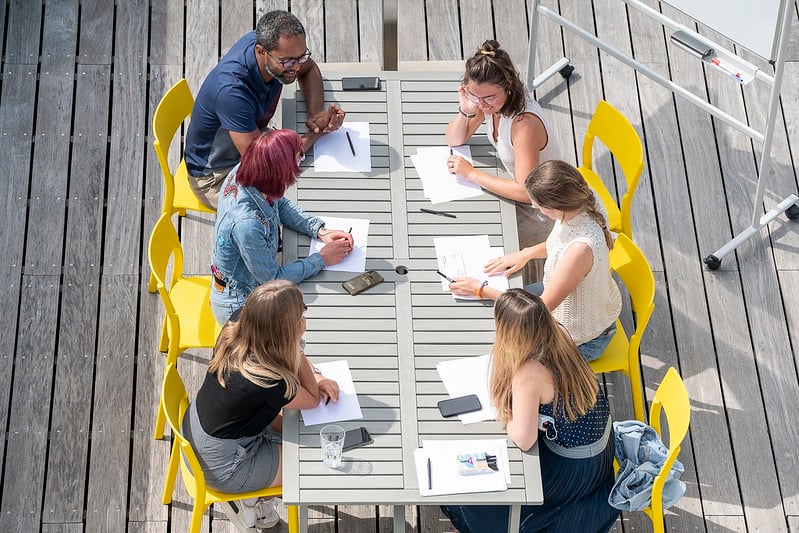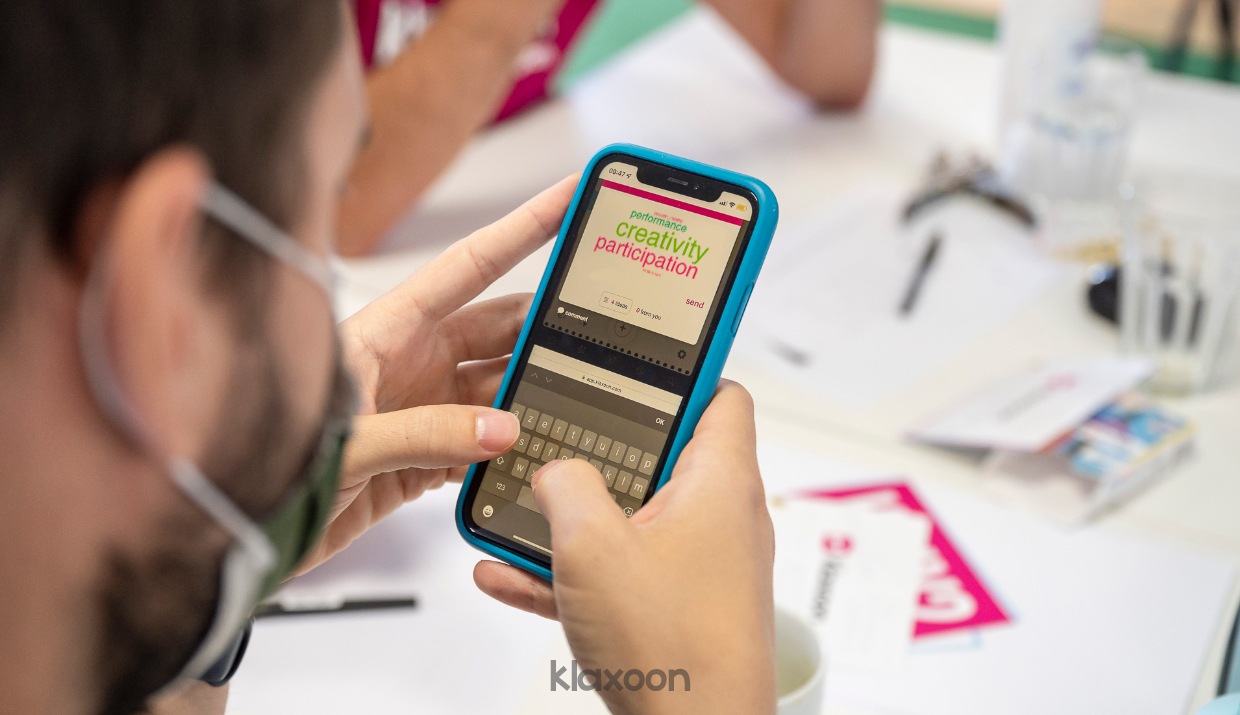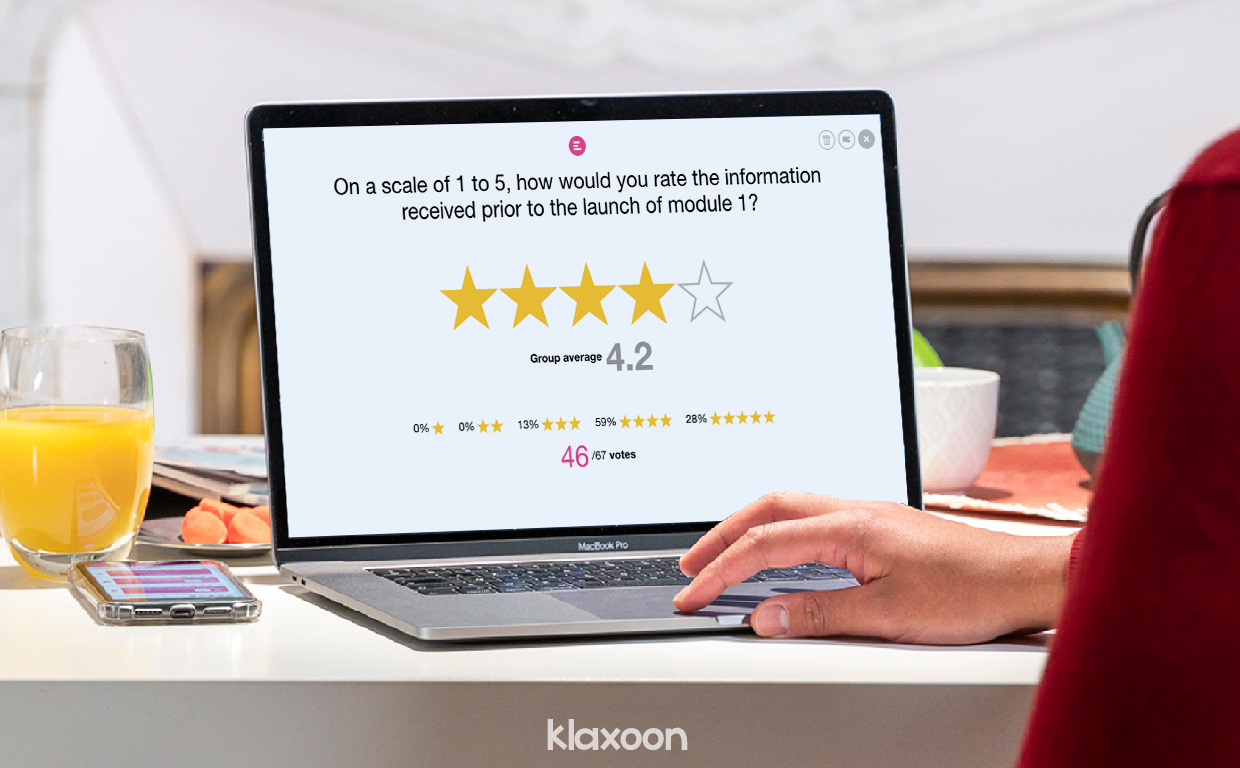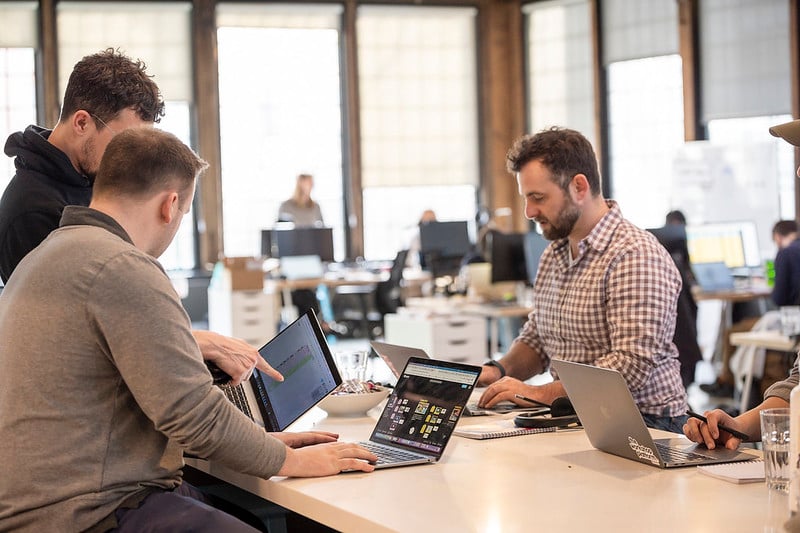4 tips for more interactive meetings
Published on February 14, 2025
4 tips for more interactive meetings
How can you put an end to ineffective meetings where the same people always speak up and no decisions are taken? Here are our 4 tips for sharing everyone’s points of view in your meetings.


Easily transform your meetings to make them more interactive.
Eloquence is the art of speaking well, using speech to persuade and convince others. Most definitely an asset in the business world. We all know someone in our circle who has an exceptional gift for telling stories - that notorious individual who could sell a refrigerator to an Inuit.
However, shyness or a formal setting sometimes prevents us from expressing ourselves freely with our colleagues, and especially during meetings. As well as eloquence, there is also the matter of time constraints and having to stick to the agenda in meetings. We all had that great idea that came to us once the meeting was over: "If only I’d thought of that earlier". It's about the pace at which we think. There are actually some easy ways to increase participation in all types of meetings.
Participation is essential. Active participation in meetings helps to solve problems, make better decisions, unleash the creative potential of a team and encourage new ideas to emerge. Unfortunately, not all of us are equal when it comes to speaking up. Daring to speak does not come naturally for everyone. Only 15% of people feel comfortable speaking in public. For others, it often brings back bad memories of school when you had to stand up and speak in front of the whole class.
The focus needs to be on new ways of expressing ourselves to encourage participation from everyone. This can be done through different ways of sharing.
For example, through pictures. You must know the adage "A picture is worth a thousand words". Why not put this into practice? A drawing, a sketch and maybe even a GIF (even though they’re not so cool now).
Similarly, writing your ideas on sticky notes is a way of expressing yourself without fear of cutting someone off or intervening at the wrong moment. And they come with the big advantage that you don’t even need to take notes any more since it’s already done.


What about writing to participate?
There are thousands of ways of expressing yourself, and there's a preferred way for everyone. Sharing your point of view and your ideas is important, so give it a go, even if you do it differently! If you don’t feel comfortable drawing or writing, you can share whatever you want: images, illustrations, documents and photos, anything that will help you express your point of view on the topic.
Any exchange should start with a question. Asking a question means you’re interested in the person you’re talking to. It creates a relationship, starts a dialog.
Questions are what we use to progress on a daily basis, at any age. For example, did you know that children ask between 30,000 and 40,000 questions between the age of two and five? This helps them to better understand the world around them. It reassures them to know why we stay awake during the day and sleep at night, why it’s hot in summer and cold in winter. By asking all these questions, they gradually become aware of their environment.
Albert Einstein said: "The important thing is not to stop questioning". And not just for yourself. In a business context, questions play an important role in team success.
This view is shared by Hal Gregersen, Executive Director of the MIT Leadership Center. For more than 30 years, he has studied the reasons why major decision-makers consistently outperform: it stems from their exceptional ability to ask questions. Questions are intimately linked to effectiveness. Top-performing salespeople ask their potential customers an average of 12 questions, compared to only 6 for the lowest performers.
Similarly, neuroscience shows that asking questions increases brain activity in the area of the brain associated with pleasure and activates the reward system. In short, the more questions you ask, the happier the person you are asking. There are compelling reasons for asking questions which people are starting to grasp.


Questions encourage everyone to participate.
As an example, Patrick Chossat is Head of Continuous Improvement at RGIS, the market leader in inventory services in France. Every week, he facilitates a team meeting with 40% of staff working remotely. In their old format, these meetings were not very interactive and always had the same problems: two or three people were monopolizing the conversation and the others kept quiet. And for people joining remotely, it was hard to follow the discussions and speak up.
Now, Patrick’s meetings have been completely transformed just by asking three questions:
This leads to a simple and engaging process, which invites everyone present to answer.
And once the meeting is over, the mission is accomplished: everyone feels involved, and Patrick gets 100% participation from the outset of the meeting. It's a no-brainer.
Which all goes to explain why questions are important to start a meeting. But what if we told you that meeting effectiveness also depends on what happens before the meeting even begins?
"What are we going to talk about?" If, you've ever asked yourself this question before walking through the door of a meeting room, this advice is for you. Meetings must have goals and generate an action plan. They need to be useful.
But if you only find out what you’re going to talk about at the last minute, it’s not really going to work. You stay on the sidelines, until the end, secretly hoping that no one will ask your opinion. And if someone does, you throw together two or three sentences and hand over to the next person. Which is why it's important to prepare your meeting in advance.
And yes, one of the keys to interactive and successful meetings is anticipation.


Anticipate the goals and topics to be discussed in your meetings.
So start straight away. Open your calendar and take a look at your next team meeting. Right now, think:
Taking the time to think about what you are going to say is the best way to save time during your meeting.
Sophie Delille, from Ticket for Change schools, initiated a new meeting format for her strategic committee. And the effectiveness of this monthly meeting soared: decision-making time was cut by two thirds.
As Sophie explains, "previously, the meeting could last three hours. The decision-maker took their own notes. Everyone had a chance to express their feelings, make recommendations and even give their approval. Often, we were left floundering in decisions, forgetting why we were there. It was all very vague."
So, Sophie has redesigned the structure of this strategic committee. Now, participants receive a folder before the meeting, summing up the topics on the agenda. They have to look at it and, based on available information, give an opinion to help the committee make efficient decisions.
Because they do this work beforehand, Sophie's strategic committee can now focus on decision-making. Those present know their topics, give relevant advice and only those topics that need to be clarified or amended are discussed. Everyone can then focus on decision-making, where collective intelligence and the need for a meeting truly make sense.
No risk of making bad decisions or wasting time on irrelevant topics because everyone is focused on the agenda and the projects to be addressed at each meeting. And this way, your meeting is a success before it even starts.
Finally, if you want to boost participation in your meetings and make them more effective, you can look at their actual structure.


Set the pace in all your meetings to make them more inclusive.
In average, a meeting lasts 90 minutes. However, scientific studies show that the average attention span is much lower. According to John Medina, author of the book Brain Rules, attention starts to wane after 10 minutes. The Pomodoro technique is based on the idea that you should work with 25-minute intervals. How do you keep people focused?
By changing the pace of meetings. Countless companies have taken this on board and developed daily meetings which last no longer than 15 to 20 minutes. During these meetings, participants, usually standing up, tell the rest of the team very quickly about what they’ve been doing and tasks to be completed that day and the following day. A short and dynamic format.
Unlock your teamwork potential